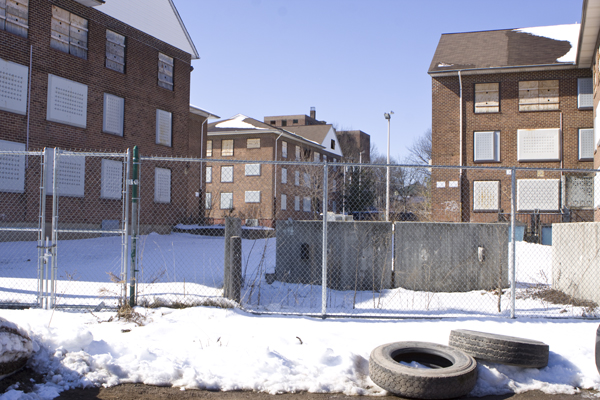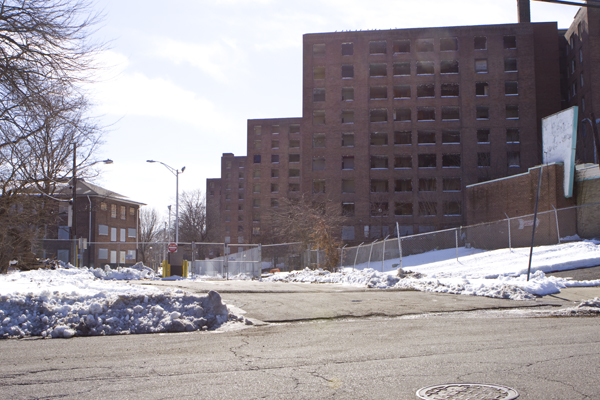DEP Protecting Polluters, Not People

Okonite Cables, Paterson, NJ – located nearby homes & schools, as well as other industrial polluters, such as Atlantic Battery (aka Power Battery). Total emissions raise cumulative impact and local toxic hot spot concerns
[Update below]
I want to examine 2 recent controversial cases in Pompton Lakes and Paterson NJ in some detail. A thorough review will clearly illustrate how DEP systematically elevates the protection of the economic interests of polluters over protection of public health.
Those are strong claims that require supporting evidence. Below, following a brief summary, I provide links to numerous documents supporting that claim.
Atypical of most similar cases in NJ, the Bergen Record has extensively covered the issues (and this) and as a result, both communities have become knowledgeable and active. In addition, Edison Wetlands Assc. is involved in helping PL residents, while Paterson community groups are getting technical assistance from Joe Morris of ICO. Very few of the remaining 565 NJ towns where there are similar problems get anywhere near this level of media attention or environmental group technical assistance.
So read on and consider both the facts individually as well as the consistent pattern and systemic nature of DEP’s actions. Consider who benefits and who bears the risks by each DEP action.
Each DEP action, taken individually, raises concerns.
Considered together as a whole it is an egregious pattern of conduct – the record is damning.
The pattern is characterized by the following DEP behaviors – please consider the cases below with these features in mind:
1) DEP withholds relevant information, erects barriers to the release of public information (particularly to activists), and fails to timely warn and fully disclose complete and accurate information to the public, while at the same time working behind the scenes confidentially with polluters;
2) DEP prepares public information (press releases, FAQ’s, advisories, Citizen’s guides, etc) and interprets information in a way that minimizes threats to public health and the environment, while portraying polluters in the most favorable light;
3) DEP resolves scientific uncertainty to the benefit of the polluter, not the public;
4) DEP provides inordinate consideration of the economic costs of compliance rather than impacts on public health, delays or forgoes common sense actions to prevent exposures, rejects the precautionary principle, and flagrantly fails to err on the side of caution;
5) DEP interprets laws, regulations, and guidance documents as narrowly as possible, in a way that narrows the scope of their responsibility, jurisdiction, authority, and scientific basis to regulate and protect the public;
6) DEP fails to aggressively use existing regulatory authority and permit and enforcement tools to reduce risks;
8. DEP recently testified in support of legislation to reduce notification to those who live nearby toxic sites on the grounds that current notification requirements were harming real estate values;
9) DEP maintains Open Public Records Act (OPRA) policies that illegally withhold public information on sham grounds of “executive” and “deliberative privilege” loopholes; and
10) DEP has taken steps to weaken existing soil and groundwater standards and vapor intrusion requirements; refused to honor promises to strengthen the cleanup program by enforcing cleanup schedules, imposing permanent remedies, and promulgating hot spot “acute soil standards“; and yet supported privatization of the program.
I) The Pompton Lakes Vapor Intrusion and Cancer Cluster story (for details, see this)

standing room only in Pompton Lakes hearing on cancer cluster associated with the Dupont pollution (12/15/09)
a) What did Dupont and DEP know and when did they know it?
Residents have demanded to know when Dupont and DEP discovered the vapor intrusion problems and why it took them so long – until May 2008 – to notify residents and begin sampling air inside homes and take steps to reduce risks. I don’t know when Dupont and DEP discovered problems at the PL site. But I do know when they should have known. DEP knew, back in early 2002 – at the highest level – that vapor intrusion was a serious statewide problem at hundreds of volatile organic compound groundwater pollution sites across the state. DEP Commissioner Campbell was warned that the current groundwater standards and cleanup approach (i.e. natural attenuation/passive remedies) would NOT protect public health. According to a February 2002 warning memo to Commissioner Campbell. Despite this warning, DEP took no quick action in PL (see the 2002 DEP Vulnerability Assessment, page 5 last paragraph):
Indoor Air from contaminated groundwater
The issue is relatively new as it relates to vapors from dissolved constituent plumes entering homes at above chronic levels. This issue is not an isolated incident (Wall Township) and has become an issue across the country. As more cases of this type surface it may cause the protectiveness of sites with natural attenuation remedies and the protectiveness of groundwater quality standards to be reevaluated.
As far as we know, 8 years later, DEP still has not revised groundwater standards to address risks from vapor intrusion or inventoried and responded to all cases where vapor risks may be present.
b) Which way does DEP err under uncertainty?
Data is always incomplete and science always uncertain. This forces policy choices to be made under uncertainty. The choices generally revolve around collect more data and wait, or err on the side of caution and take protective regulatory action. Action costs polluters money and delay increases public health and environmental risks. DEP invariably chooses delay and hides behind uncertainty. Polluters manufacture scientific uncertainty as a means of stalling regulatory action. Many DEP programs are designed to perpetuate uncertainty and avoid taking action. (see this and this)
c) What explains the delay in notifying homeowners and sampling indoor air in homes
See a and b above for answers to that. DEP recently took steps to make this problem worse at hundreds of other sites across the state. DEP adopted changes to the VI Guidance to accelerate indoor air sampling at “sensitive receptor”es (i.e homes, schools, daycare center) in August 2009, but reversed those changes in November 2009.
d) DEP blaming homeowners – DEP manipulating uncertainty regarding the source of the problem
In a Feb. 19 Bergen Record article, DEP Assistant Commissioner Kropp blamed homeowners who live on top of the Dupont plume for toxic indoor air – virtually echoing the denial excuse of the chemical industry to point the finger elsewhere. This remark reads like it is from a Dupont press release or legal brief:
One challenge of testing indoor air is that items typically found in a home, including bathroom cleaning products and chemically-treated carpet, can produce high readings for toxic vapors, Kropp said.
DEP even builds this polluters defense into the fine print of their vapor intrusion guidance document. You can see how that gets reflected in the fine print buried on page 17 of the Dupont Vapor Intrusion plan, one comes across what appears to be a benign statement (but is really an effort to blame the homeowner for any chemicals detected in indoor air):
“A building survey and chemical inventory will be completed during sample collection. The presence of consumer/household products and materials and building characteristics will be documented on a Building Survey Form (see Appendix G), adapted from Appendix B of NJDEP’s Vapor Intrusion Guidance.”
http://www.state.nj.us/dep/srp/community/sites/dupont_pompton_lakes/final_virmwp.pdf
e) DEP failed to provide information to homeowners regarding eligibility to file Spill Fund damage claims to receive compensation
No PL residents have filed NJ Spill Fund claims to receive compensation for property value reductions associated with DuPont contamination. Why is that? Because DEP hasn’t advised them that they are eligible to do so. DEP is not likely to provide that advice, because they are seeking to minimize claims against that fund. Outrageously, DEP complained in December 14, 2009 legislative testimony about how new notification requirements to residents near toxic sites were increasing Spill Fund claims. Spill Fund revenues come from a very small surcharge on major corporate polluters, primarily the oil and chemical industry. If DEP cared about protecting people, they would publicize this information and inform residents. But instead, DEP protects polluters by keeping the Spill Fund a secret to avoid public pressure on raising the surcharge when it becomes obvious that claims greatly exceed funds. DEP Guidance to the public on how to file a Spill Fund claim is limited. (See the above link to Spill Fund regulations for Spill Fund eligible reimbursements for “damages”.)
f) DEP failed to enforce toxic site cleanup, hazardous waste management, and clean water laws against DuPont
The Dupont “cleanup” has been overseen by DEP for 22 years. During that time, we are not aware of any formal DEP enforcement action filed against Dupont (e.g. Administrative Orders, Spill Act Directives, fines or penalties collected) under delegated federal RCRA or Clean Water Acts, or the tremendous DEP enforcement powers under NJ State Spill Act, Solid Waste Management Act, or Water Pollution Control Act for violations by Dupont.
g) DEP failed to impose Natural Resource Damages to compensate Pompton Lakes
DEP entered into a sweetheart deal with Dupont, yet not one penny went to Pompton lakes who have suffered enormous damages to natural resources and public health by Dupont pollution. (see this)
II) The Paterson community air toxics story (for media, see this and this)

Atlantic Battery, (aka Power Battery) directly across the street from abandoned public housing project.
Following leaks to the press, DEP recently released a major $740,000 joint EPA/DEP funded scientific research project on toxic air pollutants in Paterson, NJ. (see this). Aside from unacceptable cancer risks from numerous toxic pollutants detected in Paterson air, the study raised significant issues of scientific integrity and politicization of science. Here are verbatim DEP scientists findings that were deleted from a draft Study, followed by other serious scientific, regulatory, and policy issues that were either downplayed, sanitized, or ignored entirely in the Final Report (discussed in more detail here):
a) DEP deleted scientific research study findings in the Final Report released to the public:
1) elevated rates of respiratory disease, especially in children.
The following draft Report findings were deleted in their entirely from the final Report:
Paterson has more than three times the state average for hospitalization rates due to asthma (Wallace, 2003). A study in Paterson (Freeman et al, 2002) found that 21% of third graders had been diagnosed with asthma or a related health problem. Paterson has the fifth highest hospitalization rate for asthma in NJ (NJDHSS, 2003). Twenty eight air toxics (Leikauf, 2002) have been associated with exacerbations of asthma and the 1996 [EPA] National Air Toxics Assessment identified fourteen air toxics which are causing elevated cancer and non-cancer risks (NJDEP, 2003) in Passaic County
2) local industrial emission “hot spots”, located close to homes and schools:
The following draft Report findings were deleted in the Final report:
[Paterson] was selected because it qualifies as an air toxics “hot spot” due to the industrial (e.g. textiles; dyes; chemicals; metal fabrication, refinishing and recovery; plastics; printing; electronics; paper and food products, etc) commercial (e.g. dry cleaning; photo labs; commercial heaters/boilers; print shops, etc) and mobile sources (US I-80, Rt. 19) dominated sectors. Schools have been chosen as monitoring site locations allow UCAMPP the unique opportunity to monitor air toxics where children, a susceptible subpopulation, spend a portion of their time.
Worse, the community was provided a false rationale as to why Paterson was selected for the study.
3) Why was Paterson selected for thee study – race, ethnicity, and income statistical profile (plus “toxic hot spots”).
The following draft report findings were deleted in the Final report:
Paterson was chosen for this project because it is a mixed-use urban community with high population density and many of the characteristics of an environmental justice community. …
Paterson has all the characteristics of an environmental justice community with a disproportionately large percentage of families living at or below the poverty level. Nineteen percent of the families in Paterson live at or under the poverty level compared to 6.3% for the state. There are 149,000 residents, of which 1/3 are white, 1/3 black and the balance are some other race. Fifty percent of the population considers themselves to bee Hispanic or Latino. The population density is over 17,210 people per square mile.
4) relationship to prior Camden Pilot study and Environmental Justice concerns
The Paterson study was the next phase in north jersey, of a pilot community environmental justice initiative begun in Camden, NJ. The Camden case is highly significant, as a DEP air permit issued there to St. Lawrence Cement was stuck down by a US District Court judge on environmental justice grounds. US District Court judge Olofsky found:
“Much of what this case is about is what the NJDEP failed to consider”. It did not consider the pre-existing poor health of the residents of Waterfront South, nor did it consider the cumulative environmental burden already borne by this impoverished community. Finally, and perhaps most importantly, the NJDEP failed to consider the racial and ethnic composition of the population of Waterfront South.” ( emphasis mine South Camden Citizens in Action v. New Jersey Department of Environmental Protection, 145 F. Supp. 2d 505 (D.N.J. 2001). )
The final Report sanitizes and contains no reference to this historical, policy, and scientific context (see this and this)

abandoned public housing, directly across street from Power Battery pollution.
b) DEP suppressed consideration of cumulative impact risks presented in the draft report
Significantly, the Paterson study was the first DEP attempt to calculate “cumulative risks” by estimated “combined cancer risks” of multiple pollutants. This is a cutting edge EJ public health issue, see: EJAC 2009 Report: Strategies for Addressing Cumulative Impacts in Environmental Justice Communities-March 2009 yet all this is ignored. [Update: the risk assessment and “combined cancer risks” in the draft report have been deleted from the Final Report posted on DEP website]
The draft Report calculated “combined cancer risks” (inhalation) from multiple chemical pollutants detected in the air. Combined risks were estimated from 210 to 710 TIMES NJ’s cancer risk policy standard of one in a million lifetime excess cancer risk. (see page 61 of draft Report here)
In addition to suppressing the draft Report’s unacceptably high “combined risk” findings, the final report also failed to even mention the basic public health science concepts of cumulative and synergistic risks of multiple pollutant (or multiple pathway) exposures. The Final report failed to include any discussion of the pressing issue of cumulative risk that was presented to DEP in a March 2009 Report to DEP by DEP’s own Environmental Justice Advisory Council. According to the Council’s report: (see: EJAC 2009 Report: Strategies for Addressing Cumulative Impacts in Environmental Justice Communities-March 2009
U.S. Environmental Protection Agency (EPA) documents define the term “aggregate risk” as the risk from all routes of exposure to a single substance, and the term “cumulative risk” as the risk from all routes of exposure to a group of substances. They are silent on the issue of multiple sources. In order to have a clear and intelligible discussion about cumulative impacts, it is important for the NJDEP to agree on the definition of terms that are used. Appendix A provides some examples from various sources that might be useful. The choice of definition is not as important as assuring that everyone involved in a single conversation are all using a term with the same definition in mind.
In the mid-1990s, the EPA also developed a “Cumulative Exposure Project” that incorporated multiple pollutants, multiple sources, and multiple pathways (air, food and drinking water), but did not directly address duration. However, the EPA has not been able to extend this effort beyond the inhalation pathway which continues to be addressed by the National-Scale Air Toxics Assessment Project. (see: EJAC 2009 Report: Strategies for Addressing Cumulative Impacts in Environmental Justice Communities-March 2009
In another effort to conceal important information and misleading the public, the final Report deleted findings that the cancer risks exceeded EPA risk range policy. EPA funded the study and EPA has legal oversight over NJDEP’a air program. When EPA’s own risk range is exceeded, they are required to act to reduce those risks under EPA policy adn regulations. So the deletion of this “unacceptable risk” finding is highly significant. The draft Report found:
The combined cancer risk at all four sites were at the high end of that the USEPA considers “acceptable risk”, i.e. 1×10(-4) to 1×10(-6). The combined cancer risk was greater at the Paterson sites than at the background site. The greatest risk was observed at the C site 7.1×10(-4) [My Note: that is 710 in a million, from 7-710 TIMES HIGHER THAN EPA acceptable risk].
c) DEP downplayed the risks to minimize public health concerns – DEP spun the health risks to the community
DEP systematically downplays public health risks of the pollution levels they found by omitting key scientific findings from the study, the high air pollution related health problems cited above, while inserting claims not found in the original study. For example, DEP claims:
- “There is no immediate public health concern”. This is a conclusion that ignores evidence of significant long-term and cumulative effects – “immediate concern” is a totally inappropriate standard to apply in this case, where health effects are the outcome of chronic exposures;
- “The air quality in Paterson is consistent with that of the entire state”. This is a vague statement that ignores that the study was designed with a background monitoring station in Chester, NJ and many other specific findings such as chlorine levels in Paterson more than 100 times higher than EPA national model estimates; and
- “The cancer risk [for p-dichlorobenzene, one of 132 toxics measured] calculated at the one site in Paterson where the elevated concentrations occurred would be 205 in a million”. This statement neglects to mention that this is more than 200 times the one in a million cancer risk guideline used by DEP and that even higher cancer risks were found at other monitoring sites
- DEP completely fails to mention that the study found the :combined cancer risk” from exposure to toxic chemicals at the high end of what the U.S. EPA considers acceptable risk, and over 700 times higher than New Jersey’s cancer risk standard of one in a million
c) DEP failed to release industrial emissions inventory
One original objective of the study was to inventory all industrial emissions source within a 1 mile radius of each monitoring station. Yet that facility specific inventory is not included in the final report. Rather, DEP clasims that from 153 to 227 facilities were considered. This failure makes it impossible for the community to know where all the toxic pollution emissions are coming from and the status of DEP permits and enforcement actions at each polluting facility.
Such withholding of vital information only benefits and protects the polluter. It totally frustrates citizen efforts to hold DEP and polluters accountable to clean air laws.
To obtain this information, on December 9, 2009, I filed an OPRA public records request to DEP. That emissions inventory information has been denied.
d) DEP sanitized Report findings of flaws in DEP air permit database and permit program.
Significantly, this information is required in order to determine the status of Clean Air Act MACT compliance requirements and enforcement issues. Without the information, compliance and DEP permit performance can not be assessed by the community.
The draft Report (@page 19) – under a headline “Needed Improvements to NJDEP Emissions Databases” – made highly significant negative findings and specific regulatory improvement recommendations that were deleted from the final Report. The draft Report found:
Based on the UCAMPP and other projects done by the Department, it has been recognized that NJDEP needs to improve emissions databases. This can be accomplished by expanding current permit requirements so that facilities would have to submit stack specific speciated VOC’as and HAP’s. This would greatly reduce the resources needed to generate a detailed emissions inventory. The current requirements that major facilities report 36 HAPs at a facility-wide level in theri emissions statements needs to be expanded to include additional air toxics (possibly all those with risk based health numbers), be stack specific adn be a requirement for all sources of air emissions not just major sources and reporting thresholds need to be revised to reflect risk. The goal of any model is to try to accurately represent what is really happening in the given area of study. This can only be achieved through the input of accurate and complete data into the emissions inventory.
e) DEP failed to mandate risk reduction measures on known emission sources- DEP limited the scope of the Report and followup risk reduction measures to voluntary measures, i.e outreach and education.
This arbitrary restriction is scope again only benefits polluters because it fails to educate citizens about the full suite of regulatory and enforcement tools available to DEP to reduce pollution and public health risks in Paterson neighborhoods.
f) DEP has conducted limited to no followup source trackdown investigations and air permit and enforcement to mandate emissions reductions and reduce risks.
d) DEP is ignoring – at best – a potential lead hot spot (and could be covering it up)
(more to follow soon on suspected lead hotspot)
[Update: 3/4/10 – DEP has revised the Paterson study and posted a new Final Report version dated 2/24 – disregard criticism of the deletions described below. More to follow on exactly how the changes to the Report happened]

abandoned public housing project – within a few hundred feet of major industrial polluters. Did DEP consider cumulative impacts or EJ concerns in air permits and enforcement actions?